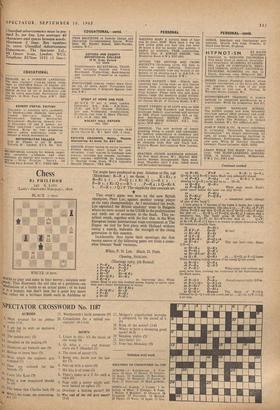Chess
By PHILIDOR
247. S. LOYD Leslie's Illustrated Newspaper, 1856) BLACK (5 men)
WHITL (6 men)
WHITE to play and mate in four moves ; solution next This illustrates the old idea of a problem-an 'Idealisation of a finish to an actual game ; of its kind it is a beauty, but don't look for a quiet key move 'In rather for a brilliant finish such as Alekhine or Tal might have produced in play. Solution to No. 246 (Shinkman): B-R 4 I, no threat. i . . . K x Kt; 2 B-Kt 3. I . . . P-113 ; 2 Kt (Kt 5)-B 7. . • P-B 3; 2 Kt ((65)- 7. I. . . P-B 4; 2 Q.--Kt 8.
P-K 5 ; x P. The simplicity that conceals art.
This week's game was won by the new British champion, Peter Lee, against another young player in the 1965 championships. As I mentioned last week, Lee captained the British students' team in Bulgaria where we were second to the USSR in the preliminaries and sixth out of seventeen in the finals. This ex- cellent result, together with the fact that in the West European junior international team tournament at The Hague we tied for first ,place with Holland without losing a match, indicates the strength of the rising generation in this country.
Incidentally, they know their openings; the first twenty moves of the following game are from a some- what obscure 'book' variation.
White, P. N. LEE. Black, D. PARR. Opening, SICILIAN.
(Hastings 1965; sth Round) • P-K4 13 4 s Kt-KB, 3 3 3 P-0, P x
Kt x Kt-K B 3
• Kt-Q B 3 Kt-B3 6 B-K 3 . . . an interesting idea; White tempts Black to give him doubled pawns, hoping to exp:oit open lines and a better development in return. 6 . . . Kt-K Kt 5 7 11-Q Kt 5 KtxB
8 P x Kt B.-'-02 9 0-.0 P-I?
to B x Kt P x13 10 . . . 13 x13; it --B 3, Q-Q 2; 12 Q R-Q 1 leaves Black very awkward'ss placed. zz P-K 5 P-Q 4 II . . . B-H. 2 is better, allowing Q-B 3 to be met by 12 ... 0-11
z3 B ,3_ Q-K a
:3 ---Q Kg 4! • • • White must smash Black's pawn centre before the latter can play 0-0.
P--Kt,y
ze P-Kt 5.! . P-Q If 4 25 P-1-K 4! ••. .. • a remarkable move (though all part of the 'book' I) I have given it 'I' because of the vision it shows, but I am not quite sure of its correctness. The idea is Is ... P x Kt; 16 P X PI (threat P-Q 6 and then Q x R th or-if Q--Q 1--Q x P mate) but after 16. . . R-B 1 ; 17 P-Q 6, Q-Kt 41 I cannot find a conclusive line. The 'book' gives sit Q xP ch, K-Q1; se Kt-1(4, 2 x P; 20 Kt-B 6-but then 20 . . . Q xP: 21 Kt xB, 13- 21 I leave it to readers to amuse themselves with the numerous possible lines. B-Kt .2 z6 KPxP 0-0 At last!
17 Kt-B6 Bx Kt z8 iPXB BxP zg R-K z B. . - .- Q 5 ch
20 -4-R z Q-Kt 4? This just loses time. Better Q R-Q r. az Kt-K4 R 5 22 P-Kt 3 K a 23 Kt-B 6 chl x Kt as Qx B Q-B a 24 ... Q x Q; 25 R x Q leaves White a winning ending because of his strong Q-side pawns. 35 R-2 z tR 1) 26 P- B4 X R 37 P-B 71 . . . White plays with coolness and
good nerve here, realising the irrelevance of the depredations of the Black queen.
Q x P
28 R-Q 8 P-K 4 Forced, to avoid 29Q x BPch. 28 R (1)-Q z FK 5 ch 39 K-Kt z K 6 ch 31 2::B 1 -Kt 4 32 (62! Resigns The threat of RxQR followed by -Q Swill costs rook and 32 ... Q x Q; 33 R (I) xQ is no help.


































 Previous page
Previous page